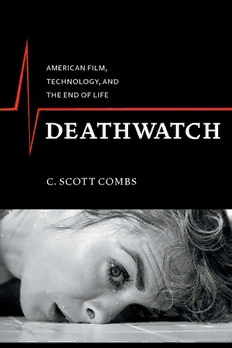
Deathwatch: American Film, Technology, and the End of Life PDF
Preview Deathwatch: American Film, Technology, and the End of Life
AMERICAN FILM, TECHNOLOGY, AND THE END OF LIFE DE AT H WATCH C. SCOT T COMBS DEATHWATCH FILM AND CULTURE JOHN BELTON, EDITOR FILM AND CULTURE A series of Columbia University Press EDITED BY JOHN BELTON For the list of titles in this series see page 277 AMERICAN FILM, TECHNOLOGY, AND THE END OF LIFE DEATHWATCH C. SCOTT COMBS COLUMBIA UNIVERSITY PRESS NEW YORK Columbia University Press Publishers Since 1893 New York Chichester, West Sussex cup.columbia.edu Copyright © 2014 Columbia University Press All rights reserved Library of Congress Cataloging-in-Publication Data Combs, C. Scott. Deathwatch : American film, technology, and the end of life / C. Scott Combs. pages cm. — (Film and culture) Includes bibliographical references and index. ISBN 978-0-231-16346-0 (cloth : alk. paper) — ISBN 978-0-231-16347-7 (pbk. : alk. paper) — ISBN 978-0-231-53803-9 (ebook) 1. Death in motion pictures. 2. Mortality in motion pictures. 3. Motion pictures—United States—History and criticism. I. Title. PN1995.9.D37C66 2014 791.43'6548—dc23 2014001350 Columbia University Press books are printed on permanent and durable acid-free paper. This book is printed on paper with recycled content. Printed in the United States of America c 10 9 8 7 6 5 4 3 2 1 p 10 9 8 7 6 5 4 3 2 1 Cover photograph provided by Photofest Cover design by Lisa Hamm References to websites (URLs) were accurate at the time of writing. Neither the author nor Columbia University Press is responsible for URLs that may have expired or changed since the manuscript was prepared. Portions of chapter 2, “Posthumous Motion: The Deathwork of Narrative Editing,” was first published in Cinema Journal 52.1 as the article “Mobile Endings: Screen Death, Early Narrative, and the Films of D. W. Griffith,” by Scott Combs, pp. 90–106. Copyright (c) 2012 by the University of Texas Press. All rights reserved. CONTENTS Acknowledgments vii INTRODUCTION: AN ELUSIVE PASSAGE | 1 1 MORTAL RECOIL: EARLY AMERICAN EXECUTION SCENES AND THE ELECTRIC CHAIR | 27 2 POSTHUMOUS MOTION: THE DEATHWORK OF NARRATIVE EDITING | 65 3 ECHO AND HUM: DEATH’S ACOUSTIC SPACE IN THE EARLY SOUND FILM | 103 4 SECONDS: THE FLASHBACK LOOP AND THE POSTHUMOUS VOICE | 143 5 TERMINAL SCREENS: CINEMATOGRAPHY AND ELECTRIC DEATH | 179 CODA: END(INGS) | 215 Notes 221 Bibliography 259 Index 269 ACKNOWLEDGMENTS MANY OF my teachers leave their marks on this book. I was trans- formed at the University of Chicago, where I sat as an undergraduate in Tom Gunning’s classes on early cinema. Our conversations over the past decade have helped to shape many of the arguments that follow. Also at Chicago, James Lastra endured long office hours with me; many years later, he inspired my writing. The early stages of this book were researched and written at the University of California, Berkeley, where I was a graduate student. I am indebted to a number of professors and colleagues there, especially Carol Clover, without whom this book would not exist. Our conversations oriented me in the material and continue to inform my thinking and writing. Linda Williams offered tough and indispensable criticism at every step. Guy Micco generously donated his medical films, expertise, and friend- ship. Anne Nesbet provided insightful feedback on early drafts; Mari- lyn Fabe invited me to lecture on early cinema at a pivotal moment and always offered support. Several interlocutors in the Berkeley com- munity influenced this book: Sylvia Chong, Amy Corbin, Guo-Juin Hong, Russell Merritt, Mark Sandberg, Gordy Steil, Andrée Toussaint, and Kristen Whissel. A number of colleagues at St. John’s University have read this book in its late stages, either in part or in whole: thanks to Amy King (for her inexhaustible support, acuity, and rigor), Dohra Ahmad (for her ACKNOLWEDGMENTS | viii feedback on early sections), Kathleen Lubey (for her candor about ducks and pinchers), John Lowney (for the Americanist queries). Stephen Sicari managed my anxiety with admirable grace. I am also grateful to Adam Lowenstein for helpful commentary on a late draft. Special thanks to Domietta Torlasco for her sensitivity to images and her intuitive grasp of the personal stakes of this project. My friend Douglas Lindeman did not live to see the completion of the book, but his words of confidence helped create it. So many students at St. John’s have kept me going—especially John Nance, Jeffrey Maiorino, and Stephen Pasqualina. Thanks to Phillip Grayson for his diligence. A large portion of this was written at Igloo Café in Astoria, New York; I thank the establishment and everyone working there. Thanks to my circus friends for the artistic and athletic outlet. I want to thank my parents, Charlie and Lorraine, and my sister, Cindy, who supported my decision to think and write. My life has been defined by my experiences as a student, and it is for all of my teachers that I have the biggest sense of gratitude. I would especially like to thank Virginia Marcus, my eleventh grade English and Humanities teacher, who came into my life and redefined its pos- sibilities. It is to her that I dedicate this book. DEATHWATCH
